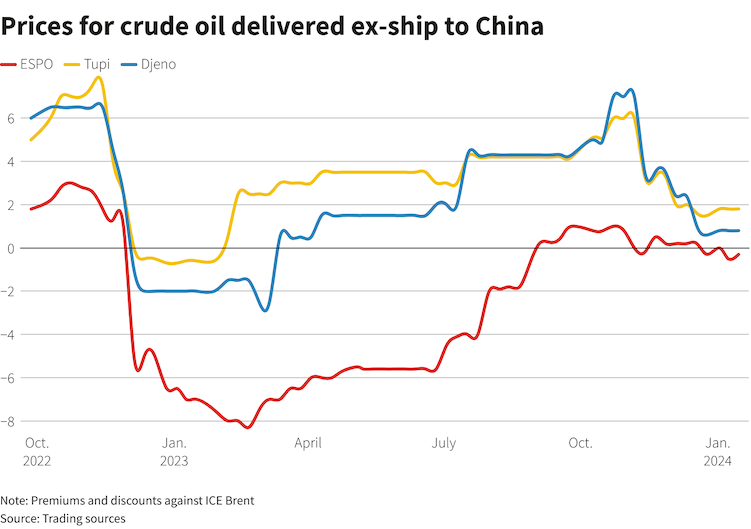Russia became China’s top crude oil supplier in 2023, exporting far more than other major oil exporters such as Saudi Arabia, data released on Saturday showed.
The People’s Republic, which is the world’s biggest crude importer, defied Western sanctions to purchase vast quantities of discounted oil for its processing plants.
Russia shipped a record 107.02 million metric tons of crude oil to China last year, equivalent to 2.14 million barrels per day (bpd), data from Chinese customs showed.
ALSO SEE: China Firms Using Own Cash to Launch ‘Sponsored’ Equity Funds
Imports from Saudi Arabia, previously China’s largest supplier, fell 1.8% to 85.96 million tons, as the Middle East oil giant lost market share to cheaper Russian crude.
Shunned by many international buyers following Western sanctions over the Kremlin’s 2022 invasion of Ukraine, Russian crude oil traded at significant discounts to international benchmarks for much of last year amid a Western-imposed price cap.
Accelerating demand from Chinese and Indian refiners for the discounted oil boosted the price of Russian ESPO crude through 2023, pushing past the Group of Seven’s $60 a barrel price cap imposed in December 2022 as alternative shipping and insurance options to circumvent the sanctions proliferated.

Reuters Graphics
ESPO crude shipments for December delivery were priced at a discount of around 50 cents to 20 cent per barrel to the ICE Brent benchmark, versus a $1 premium for October delivery cargoes and a discount of $8.50 for shipments delivered in March, according to trading sources.
At the same time, Saudi Arabia raised prices for its signature Arab Light from July, pushing some refiners to look for cheaper cargoes.
To support prices, Saudi Arabia and Russia, two of the world’s top three oil producers, announced output and export cuts last year. Saudi Arabia is rolling over output cuts of 1 million bpd this quarter, while Russia said it would deepen its cut in exports this year to 500,000 bpd from 300,000 bpd.
Chinese refiners use intermediary traders to handle the shipping and insurance of Russian crude to avoid violating the Western sanctions.
Buyers also use the waters off Malaysia as a trans-shipment point for sanctioned cargoes from Iran and Venezuela. Imports tagged as originating from Malaysia climbed 53.7% last year.
China reported no official shipments of Venezuelan crude in December despite an easing of US sanctions on Caracas in October following a deal between President Nicolas Maduro’s administration and its political opposition.
Shipments to China from the US last year surged 81% last year despite geopolitical tensions between Beijing and Washington as US crude production increased.
China’s overall crude imports for 2023 rose to a record of 563.99 million metric tons, equivalent to 11.28 million bpd. A metric ton is about 7.3 barrels of crude oil.
- Reuters with additional editing by Jim Pollard
ALSO SEE:
Russia Says Sanctions Helped Cement China, India Energy Ties
China-Russia Trade Worth $218bn as Moscow Leans More on Beijing
Russian Oil Trading with India Still Plagued by Currency Woes
China, India Imports of Russian Oil Surge to Record Highs
























